Questions and Answers: December 2014
In each issue of e-gardens, Neil answers your questions. However, because this is a visual medium, he selects only from those submissions that have come in with photos attached. He chooses those questions that will be of the greatest reader interest. Send him your question here. And now, here are his answers to this month’s questions.
Question: What is this weed? More importantly, what can I use to eliminate it? Remedies from the nursery haven’t helped. M.P., Fort Worth.
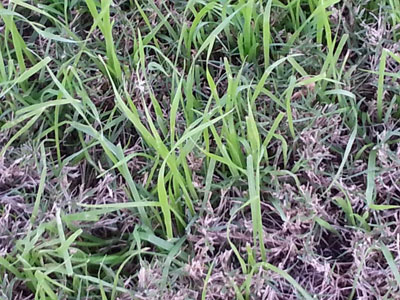
Answer: This is a winter grass, probably rescuegrass. It germinated in September and is now established and growing. The only way that annual grassy weeds can be eliminated is by preventing their germination at the outset. In the case of cool-season grasses like ryegrass, rescuegrass, and the most common of all, annual bluegrass (Poa annua), that would mean applying Halts or Dimension sometime in the first week of September. For crabgrass and grassburs, at least in the Metroplex, you would apply either of those materials March 5 -15 (two weeks prior to the average date of the last killing freeze), with a repeat treatment June 5-15 (90 days after the first treatment). Unfortunately, there is no “second chance” at eliminating them once they are up and growing.
Question: My red oak has been growing very well, but it did sustain damage in last year’s ice storm (loss of two major limbs). About two months ago, I noticed that the leaves on the west side were not the normal dark green color. I also see what looks like galls on the stems. Is this serious? If so, what should I do about it? P.W., Red Oak.
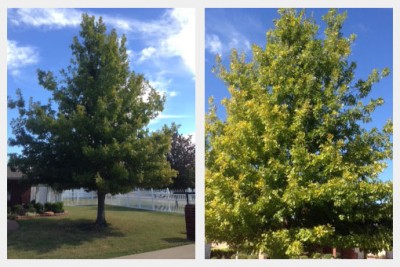
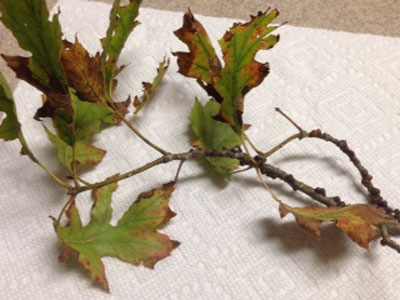
Answer: Get a certified arborist on-site to look at your tree. The first thing I would wonder is if you have a true Shumard red oak (the one for which your city is named), or whether you might have northern pin oak (Quercus palustris). Pin oaks grow well for a few years when planted in alkaline soils, but they begin to show serious iron deficiency symptoms (yellowed leaves with dark green veins, eventually turning browned and brittle – always on the newest growth first). This looks like that type of nutrient deficiency, and the profile of the tree looks like it might support its being a pin oak.
Shumard red oaks and pin oaks look very similar in the nursery, and growers and retailers sometimes get them labeled incorrectly.
The nodules are scale insects. Russell Peters of Arborilogical Services says the infestation is heavy enough to be of concern. He suggests using an over-the-counter systemic insecticide containing Imidacloprid in the spring.
As for the yellowing, it’s possible the limb loss added to the stress on that side, and it’s also possible that the tree’s roots have hit alkaline white rock more on the one side. The bad news is that adding iron is only a short-term fix that will never offer permanent help. In fact, as you nurture this small to mid-sized tree, it and its problems will just continue to get larger.
Those are the things I’d ask the certified arborist to help you with.
Question: My crape myrtle has three large trunks (6-inch diameters each) that have been trapping water for a period of time. I’m concerned the wood will become weakened. Would it help to put sand in? I know it would still trap water, but the sand would displace much of it and dry out faster. Thoughts? C.P., North Garland.
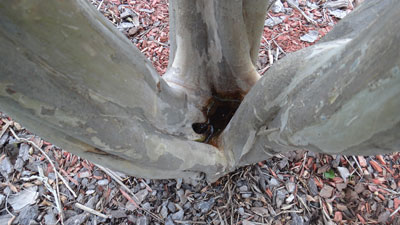
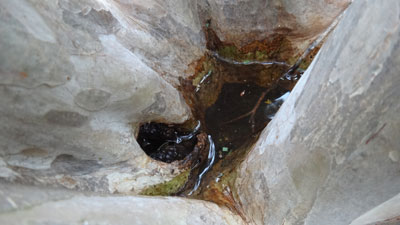
Answer: Certified arborists have taught me that trees “wall off” from damage in this sort of situation. They have encouraged me not to worry about it in the trees on our property. But I checked with Russell Peters of Arborilogical Services (and one of our state’s finest arborists) just to be sure. I sent him your photos. He agreed and suggested flushing it out with fresh water two or three times a year. My bet is that it will go away as the trunks grow larger.
Question: Two junipers we planted three years ago have hardly grown, and they look just like this. I’ve tried nitrogen, iron, and spider mite controls, and nothing has seemed to help. I’m tired of having them look like this. Suggestions? N.P., Aubrey.
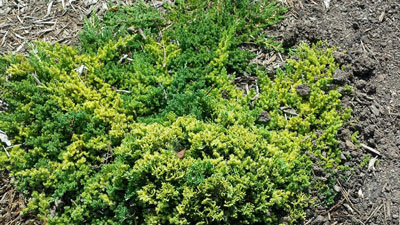
Answer: It looks like the soil could have used improvement with organic matter of several different types at the time of planting. This problem may simply be a sign that the junipers are not happy with your black clay gumbo. I don’t know that it’s related to any of the three issues you addressed. I commend you, however. You’ve done your homework — those are the most common problems that junipers encounter. Tam junipers grow in a fairly similar, low, spreading habit, and they’re far more dependable.
Question: Why would one of my Rose Creek abelias look weak, while others are robust? Will the weak plant come back well? How and how much can they be trimmed? M.G., Forney.
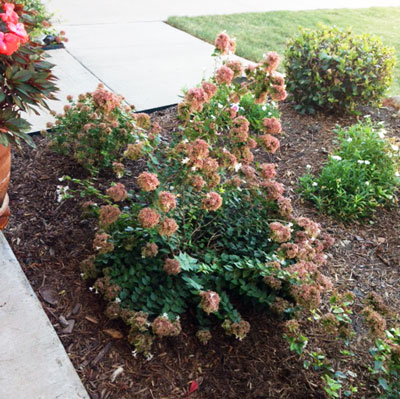
Answer: Your vigorous plants prove that they’re adapted in your area. About the only thing that is likely to have varied between plants this close together would have been moisture. It’s most likely that the weak plant got too dry at some point. Leave it in place. Trim it lightly to even out its growth, then water it and the others regularly. Apply an all-nitrogen fertilizer in spring.
Question: I wanted evergreen wisteria to cover my pergola. Someone got me some seeds. This photo is of the largest one, but the plant seems to have stalled out. I water it regularly. What more can I do? Should I take it indoors this winter? M.M., Burleson.
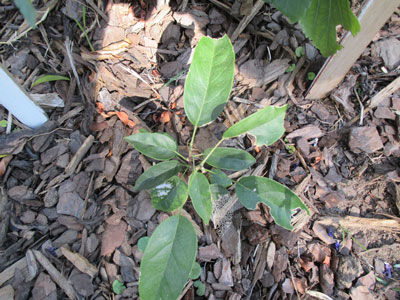
Answer: Hmmm. Evergreen wisteria (Millettia reticulata) has compound leaves. These are simple leaves. Perhaps this is juvenile foliage, or perhaps someone handed you seeds that weren’t truly from evergreen wisterias. The only two things these plants need to thrive are water and nitrogen. You might give those a try next spring. If all else fails, buy a started nursery plant. It might save you a lot of frustration. It looks like you would have to dig this plant up to move it indoors. That’s not a good solution. It might be easier to pile leaves up over it if the weather turns unusually cold.
Question: I planted a bur oak from a container two years ago. It has grown well, except I see this damage to its trunk, and beetles that I’m told could be adult borer insects alongside it. What should I do? T.C., Dennis.
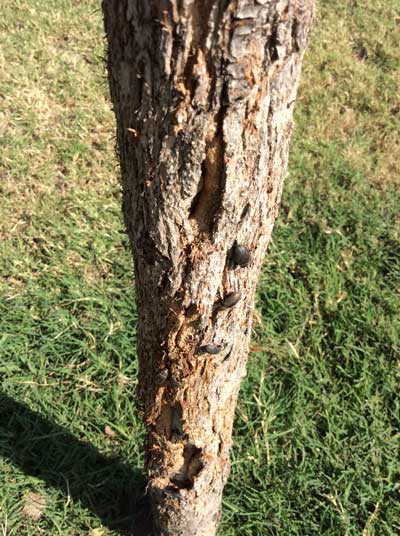
Answer: This one is really odd. Since I was bothering him anyway, I sent your question and the photo to Russell Peters of Arborilogical Services. He is a former Arborist of the Year for Texas – knows his trees!
In response to a couple of my comments, Russell said: “I cannot find any information on that huge beetle that appeared to be boring into the bark tissue of the small bur oak. I agree with you in that the damage is older and I feel likely due to old borer injury the first year and the tree has recovered from that with no active infestation apparent.”
Question: These webs get on my oak trees each fall, but this year was worse than ever. (Photo is from a couple of weeks ago, before the first freeze.) What should I do next fall? J.B., no city given.
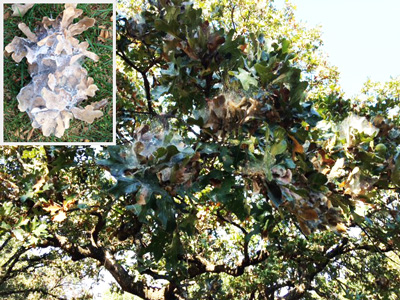
Answer: I realize I’ve asked for his help several times in this one issue of e-gardens, but Russell Peters of Arborilogical Services is such a great ally, I asked him about your oak clusters, too. He feels these are due to “spiders that have created ‘lodges’ or possibly fungal mycelia growing over the clump of dead leaves in a saprophytic manner. Nothing harmful that I recall.”
Question: I have tried and tried to kill mistletoe in my oak tree. I have scraped it off a few branches, and I’ve even removed entire branches. Is it a losing battle? Is there anything special I can do to stop it? J.R., Amarillo.
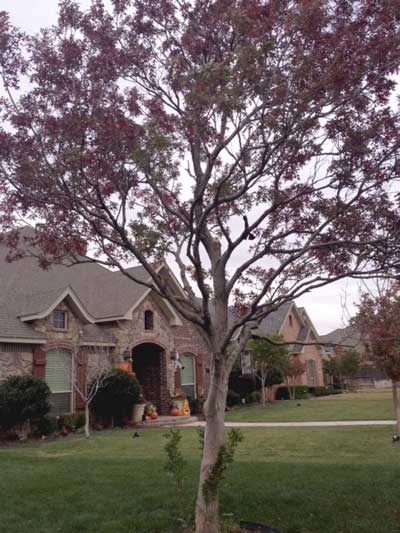
Answer: You’re doing a great job of landscaping in a challenging climate. Well done! Honestly, I wouldn’t have expected the mistletoe to survive your winters. I must confess that I’m having trouble seeing it in the photo, even after zooming. You might want to hire a certified arborist. They have access to a product that might offer some promise. It hasn’t always proven completely effective, but it does help. Otherwise, what you’ve been doing is about all consumers can do. The parasite roots into the mother (host) tree, so any kind of weedkiller you might spray on the mistletoe will also damage the tree.
Question: I have all these starter trees coming up beneath an oak tree. I suspect they are coming off the roots and not from acorns. Is there any way of eliminating them from this tree, or will I need to start a new tree? L.W., Katy.
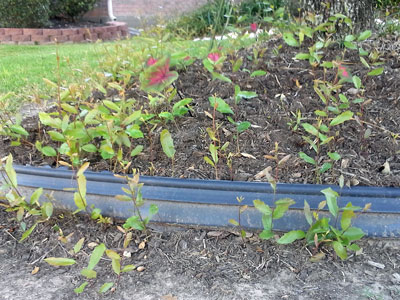
Answer: You’re correct. These are root sprouts and not seedlings. This is a genetic blemish of (my estimate) 10 or 15 percent of our live oaks. Unfortunately, short of removing the tree or hand-digging the sprouts as they appear, there isn’t anything you can do. They are part of the mother tree, and sprays you apply to kill them will quickly be carried up to the main tree. If these are too obnoxious, you’ll want to consider another high-quality shade tree.
Question: My several young bur oak trees all turned tan about six weeks ago. I should have written earlier, but is this anything that would have caused long-term damage? S., No city given.
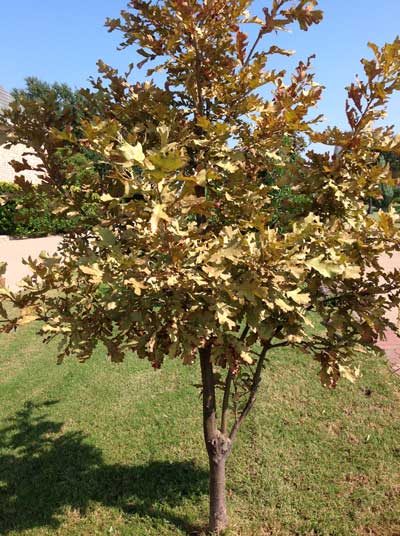
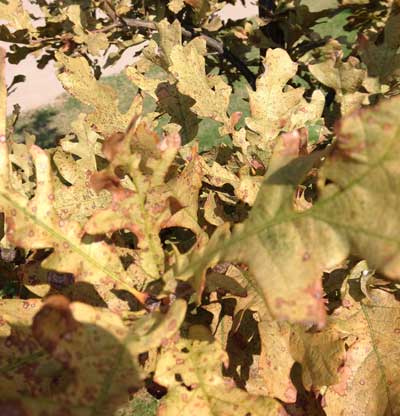
Answer: This is damage done by lace bugs, and in the whole scheme of things, it’s extremely minor. Some years will be worse than others. I have larger bur oaks that have gone 15 or 20 years between bouts with them. They suck the color out of the leaves, but the trees recover quickly the next spring. Your only remedy would have been to apply a systemic insecticide through the soil four to five weeks before you saw the damage this year. While the trees are small, you could also spray them with a systemic material just as the problem starts to show up.

